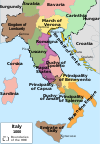Ansprand

Ansprand (c. 657 – 712) was king of the Lombards briefly in 712. Before that, he was the duke of Asti and regent during the minority of Liutpert (700–701). He was defeated at Novara by Raginpert and exiled during the subsequent war over the succession, fleeing to the court of Theudebert, duke of Bavaria, in 702.
In 711, he returned with a large army from the duke. Many Austrians (the men of Venetia and the east) joined the returning regent and battle ensued near Pavia, between his forces and those of King Aripert II, who had usurped the throne. Aripert fled to his capital when the tide went against him, but he hoarded the treasures and tried to cross over into Gaul by night. He drowned in the Ticino River and Ansprand was acclaimed sovereign.
He ascended the throne in March and died in June, leaving his only surviving son, Liutprand, the kingdom.[1] He was married to Teudelinda (8th-century), and was the father of Imberg.
Notes
- ^ "German Tribes org Lombard Kings". GermanTribes.org. Archived from the original on 2010-07-18. Retrieved 2010-07-18.
| Regnal titles | ||
|---|---|---|
| Preceded by Aripert II | King of the Lombards 712 | Succeeded by Liutprand |
- v
- t
- e
- Odoacer (476–493)

- Theodoric (493–526)
- Athalaric (526–534)
- Theodahad (534–536)
- Vitiges (536–540)
- Ildibad (540–541)
- Eraric (541)
- Totila (541–552)
- Teia (552–553)
- Alboin (568–572)
- Cleph (572–574)
- Interregnum (574–584)
- Authari (584–590)
- Agilulf (590–616)
- Adaloald (616–626)
- Arioald (626–636)
- Rothari (636-652)
- Rodoald (652–653)
- Aripert I (653–661)
- Godepert (661–662)
- Perctarit (661–662)
- Grimoald (662–671)
- Garibald (671)
- Perctarit (671–688)
- Cunipert (688–689)
- Alahis (689)
- Cunipert (689–700)
- Liutpert (700–702)
- Raginpert (701)
- Aripert II (702–712)
- Ansprand (712)
- Liutprand (712–744)
- Hildeprand (744)
- Ratchis (744–749)
- Aistulf (749–756)
- Desiderius (756–774)
- Charlemagne (774–814)
- Pepin (781–810)
- Bernard (810–818)
- Lothair I (818–855)
- Louis I (855–875)
- Charles II (875–877)
- Carloman (877–879)
- Charles III (879–887)
- Arnulf (896–899)
- Ratold (896)
(title disputed 887–933)
- Unruochings: Berengar I (887–924)
- Guideschi: Guy (889–894)
- Lambert (891–897)
- Welfs: Rudolph (922–933)
- Bosonids: Louis II (900–905)
- Hugh (926–947)
- Lothair II (945–950)
- Anscarids: Berengar II (950–963)
- Adalbert (950–963)
the Holy Roman Empire
(962–1556)
- Otto I (962–973)
- Otto II (980–983)
- Otto III (996–1002)
- Arduin I (1002–1014)
- Henry II (1004–1024)
- Conrad II (1026–1039)
- Henry III (1039–1056)
- Henry IV (1056–1105)
- Conrad II (1093–1101)
- Henry V (1106–1125)
- Lothair III (or II) (1125–1137)
- Conrad III (1138–1152)
- Frederick I (1154–1186)
- Henry VI (1186–1197)
- Otto IV (1209–1212)
- Frederick II (1212–1250)
- Henry VII (1311–1313)
- Louis IV (1327–1347)
- Charles IV (1355–1378)
- Sigismund (1431–1437)
- Frederick III (1452–1493)
- Charles V (1530–1556)












